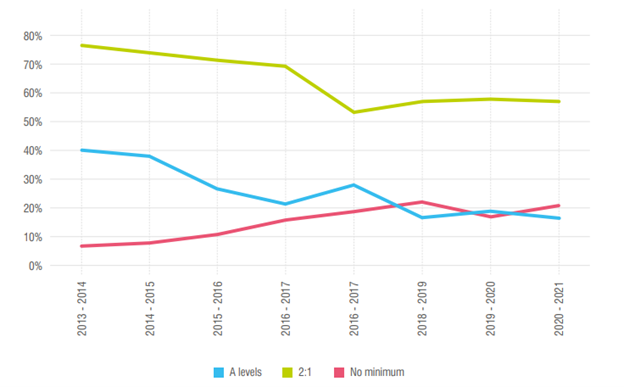Making a clear commitment to diversity and inclusion as an organisation starts with the selection process.
How a company recruits and selects talent for their vacancies, will determine their ability to improve diversity within the organisation, providing more equal and inclusive opportunities.
In our latest ISE Student Recruitment Survey, Nicola Thomas, Head of Research at ISE, looks at how employers are running their selection process and how they account for diversity and inclusion.
Over the last 10 years, it’s not just organisations that have turned their focus to diversity and inclusion in the workplace. As we’ve shifted towards a more candidate driven market, we’re seeing more and more professionals seeking out workplaces which align with their personal values.
Now more than ever, there are increasing demands on organisations to put diversity and inclusion at the centre of their operations.
Organisations need to demonstrate their commitment to diversity to attract the best talent.
This is specifically important when it comes to their early career hires. We know that generation Z are highly value driven, seeking to work for organisations that align with their personal values.
How do you make the right decision during the hiring process?
Most employers set some minimum requirements when it comes to job applications. For graduate roles, a 2.1 degree is the most common requirement. Over half (57%) of organisations stipulate this when hiring graduates.
However, it’s rare that an employer expects a specific subject degree. Only 14% of our survey respondents said they had specific subject requirements, with only 2% requiring a postgraduate degree.
Not surprisingly the need for specific degrees were more common in Legal, Finance & Professional Services and Health & Pharmaceutical sectors where most job roles require dedicated qualifications.
The most used selection activities were interviews and assessment centers, along with application forms.
Almost all of these activities were completed virtually. It’s also not surprising that interviews and assessment centers were considered the most effective activities for employers to base final recruitment decisions on.
How to increase diversity in your selection process
There are many different approaches taken by organisations. The most common one across all organisations was diversity monitoring (deployed by 70% of employers).
Two other commonly applied methods were to analyse the outcome of previous campaigns to understand diversity, reported by 62%. Followed by training staff involved in the selection process for diversity and unconscious bias, reported by 58% of employers. This is consistent with trends of previous years.
Encouragingly, the majority (93%) of respondents had altered their selection process to maximize diversity in the candidates they hire.
Through looking at how the use of educational minimum requirements has been changing over the last few years, we can see that the trend to experiment with no minimum requirements has steadily been declining.
When it comes to diversity and inclusion, there are some strong arguments for why employers might want to consider removing their minimum requirements, or at least to lower their demand on educational qualifications.
Figure 1. Employers using educational qualifications as a minimum requirement 2013/2014-2020/2021

It’s time for action
It’s important that organisations keep on top of their diversity and inclusion practice within their selection process. Employers should make sure they regularly review how well their approaches are working and course correct as necessary
Otherwise, internal diversity and inclusion strategy risks becoming nothing more than a checkbox activity.
While diversity monitoring was one of the top deployed activities for diversity and inclusion in the selection process, the least applied approaches were near-miss schemes (to take in candidates who just missed the pass mark). In addition to simplified or re-ordered selection stages.
Both of these were only used by 10% of respondents. While monitoring for diversity is important, it’s crucial that employers are also ensuring they are deploying concrete ‘action-oriented’ approaches in their selection process to ensure more diverse hires.
Figure 2. Approaches taken by organisations to improve diversity in selection

Diversity and inclusion are fast becoming a cornerstone for many organisations seeking to attract and select the best talent on the market.
The majority of organisations are committed to making diversity part of their selection processes. However, we need to ensure that this inclusion doesn’t just limit itself to reporting and monitoring.
What is crucial moving forwards, is that organisations are taking more concrete action to allow selection from a more diverse pool of talent.


0 Comments